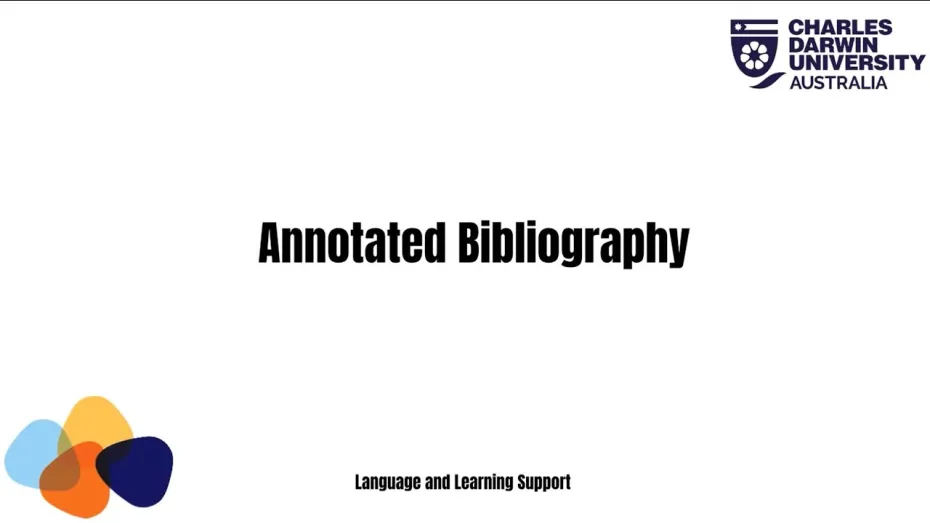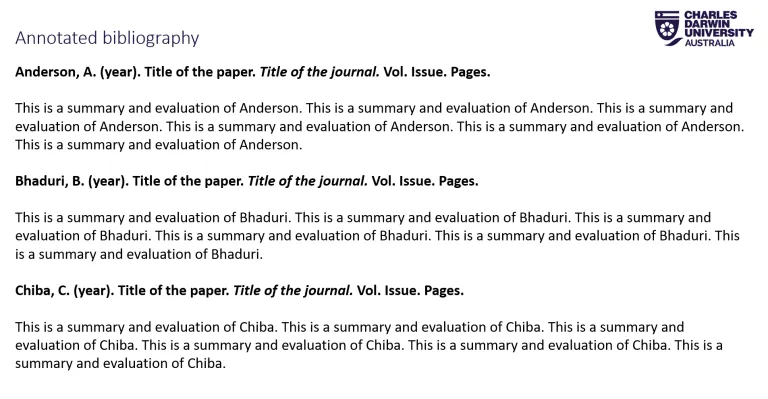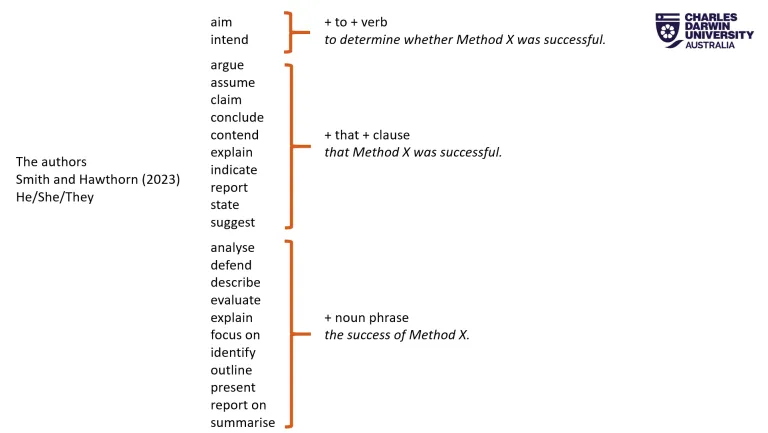An annotated bibliography is a list of references (bibliography) which includes a summary and often a comment on or evaluation of each reference. It is a common assessment task at university because it develops your research and reading skills and can prepare you for later writing tasks.
This page will help you to meet your lecturers' expectations by:
self-evaluating your current strengths and weaknesses
understanding the purpose of annotated bibliographies
developing your ability to select and evaluate sources
structuring your annotations appropriately
making appropriate language choices.
Download this summary sheet for your own reference.
Introduction to annotated bibliographies
All scholars refer to the work of other scholars in their writing. They are participating in a type of academic conversation that helps to build knowledge in their discipline. As a student, you also participate in this conversation by referencing the experts in your field. Writing an annotated bibliography develops your ability to do this.
Self evaluation
Reflect on your previous experience. How would you rate your ability in the following annotated bibliography skills? Rate your ability from ‘good’ to ‘needs development’.
Congratulations if you feel confident about your skills. You may find it helpful to review the materials on this page to confirm your knowledge and possibly learn more. Don't worry if you don't feel confident. Work through these materials to build your skills.
An overview of annotated bibliography tasks
Watch this video to learn more about annotated bibliographies.
Reflect on what you have learned in the video about annotated bibliographies and literature reviews
Confirm your ideas by dragging and dropping the following elements into the correct place in this table.
Purpose of an annotated bibliography
Annotated bibliographies can have several goals depending on the assignment.
Read the instructions for your annotated bibliography task in your unit and reflect on these questions.
Why do you think your lecturer has set this task? What is the purpose of the annotated bibliography?
How does this task fit into the assessment plan for the unit? Does it prepare you for a later essay or literature review?
Which unit learning outcomes will the task help you to achieve?
Consider the possible goals of an annotated bibliography. Which of the following is NOT a reason to write an annotated bibliography?
Steps to writing an annotated bibliography
The following steps can guide you through the process of writing your first annotated bibliography.
| Step 1 | Read the instructions very carefully to ensure you understand task requirements. You should check, for example:
|
| 2 | Analyse the topic very carefully to ensure you understand the scope of the task. |
| 3 | Conduct research to locate potentially useful texts. The subject guides in the library can help you get started. |
| 4 | Select appropriate sources. Visit the Library page on evaluating sources to help you. |
| 5 | Record the bibliographic details of the sources you locate. Use the required reference style to do this. If you are not sure which style is required, ask your lecturer. |
| 6 | Evaluate and critically read the sources you have located. |
| 7 | Make notes of the key points and the strengths and weaknesses of each source. |
| 8 | Put the original sources away and use your notes to write a summary for each of your annotations. |
| 9 | Use your notes to add your critical comment that evaluates each source and its usefulness, if required. |
| 10 | Quickly reread each source to check that your summary is accurate and your evaluation is fair. Edit and proofread your document before submission. |
Download a copy of these steps and use them as a checklist as you do your assignment.
Structure and content
Annotated bibliography tasks can vary in their required structure and content. So, read your task instructions carefully, and if in doubt, ask your lecturer.
Structure
Annotated bibliographies aim to describe sources about a specific topic.
Most simply require a list of sources and annotations organised in alphabetical order according to the first author’s surname.
Some may require you to begin with a brief introduction that announces the topic and aim and end with a conclusion that synthesises the main points that have emerged from the annotations.
Examine this sample below. Remember:
- each annotation is separate
- the annotations are in alphabetical order
- you must use the reference style stated by your lecturer (not the one in the sample below).
Although annotations are not long texts, you should pay attention to using clear paragraph structure. Short annotations may comprise one paragraph, while longer annotations may comprise two or even three paragraphs. Revise paragraphs if you are not sure about clear paragraph structure.
Content
All annotations begin with the bibliographic details of your chosen sources followed by a paragraph that summarises the content. Many also include a comment that evaluates the source.
Your summary and comment may include some or all of the following points:
| Citation |
|
| Summary |
|
| Comment |
|
Read your instructions carefully to check your lecturer's requirements.
Read these annotations and think about which of the elements the writer has included. Then, click on the hotspots to confirm your thoughts.
Reflect on what you have learned so far about annotations. Read the following sentences from an annotation and put them in the most appropriate order.
Evaluating sources
An important skill for writing annotated bibliographies (and literature review assignments) is the ability to critically evaluate sources.
Selecting sources
The CRAAP test offers a series of questions about currency, relevance, authority, accuracy and purpose to help you choose good quality sources.
Download and print this useful document from the CDU library so you can refer to the questions while you are researching.
Evaluating sources
To evaluate the content of most texts, you should focus on these main areas:
the overall credibility of the text
the quality of the argument and evidence
the style and tone.
Visit Reading critically for a list of suggested questions that guide your analysis and evaluation.
Evaluating research
To evaluate research articles, use this list of questions to help you identify strengths and limitations.
Introduction and literature review
Is the hypothesis or aim of the research clear?
Do the researchers clearly show that their study is meeting a need or filling a gap in our knowledge?
Do the researchers show how their study builds on previous research?
Method
Is any theoretical framework explained and justified?
Is the study design made clear? For example, is it a randomised controlled trial? A longitudinal study? A systematic review?
Is a rationale given for the chosen method?
Is the research ethical?
How detailed is the methods section? Are any steps missing or unclear? For example, how big is the sample? Is enough information given about participants?
Do the researchers explain how they control variables?
Results
Are data analysis tools identified?
Are the steps in the data analysis explained and justified?
Are the results relevant to the aim?
Are the results explained?
Do tables and graphs support the explanation?
Discussion and conclusions
Are claims or conclusions supported by the results?
Do the researchers discuss the extent of their success in testing the hypothesis or meeting their aim?
Do the researchers discuss the limitations of their study?
Does the discussion section contribute to scholarly debate on the topic?
Useful language
You can incorporate your summaries and comments more seamlessly into your annotations (and into literature reviews) if you use clear language to guide your reader.
Signpost language
Remember that it is the responsibility of the writer to make their writing as clear as possible for their readers. Download and print this document and keep it above your desk for reference when you are writing.
Read through the useful language and complete the task below.
Now, fill the gaps in the sample annotation.
Tense
When you write your annotations, take care that you use the most appropriate tenses.
- Read these extracts and pay attention to the verbs.
- Choose the most common tenses for the different elements of an annotation.
Reporting verbs
In annotated bibliographies, or any task in which you refer to sources, you will need to use reporting verbs accurately and appropriately.
Refer to the list below:
|
|
Ensure you understand the meaning of each of these reporting verbs. Read these groups of reporting verbs. In each line, which one does NOT belong?
Annotated bibliographies and generative AI
Using generative AI (GenAI) ethically for annotated bibliographies is important for maintaining academic integrity and developing research skills. While GenAI can help find relevant sources and suggest evaluation points, students must ensure their annotations reflect their own understanding. Over-reliance on AI can undermine the purpose of an annotated bibliography, which is to demonstrate critical engagement with sources. Submitting annotations that don't represent a student's own evaluation breaks academic honesty policiesand hinders the growth of essential critical thinking and research skills.
Limitations of GenAI for annotated bibliographies
GenAI has limitations when writing annotated bibliographies, which need careful thinking and accurate evaluations of sources. Unlike general academic writing, annotated bibliographies require a good understanding of each source's importance and reliability—areas where AI often struggles. While it can create clear summaries, GenAI does not provide the depth needed to critically assess a source's arguments, methods, or biases, resulting in generic annotations that may miss important insights. It might also fail to accurately represent a source's scope or limitations, leading to misunderstandings that can harm the research process.
Have a look at the annotated bibliography task below, its marking rubric, and the sample provided. Do you think the sample addresses the task requirements and the elements in the rubric?
Now answer questions 1-5 below.
Click on the hotspots below to see all the issues with the AI-generated annotated bibliography. Then compare it with a sample written by a student.
Prompts to help you get started with your annotated bibliography
Prompt engineering is a pivotal skill in leveraging AI effectively for academic and professional purposes. Clear and specific prompts, such as those focusing on outlines or research plans rather than final products, foster deeper engagement with the subject matter and uphold academic integrity.
See below some prompts to help you get started with your next annotated bibliography.
We also encourage you to review our study skills page “Using AI tools at university” and download the GenAI Quick Tips sheet to learn more about how to use GenAI effectively and ethically.
Applying your learning
Reflect on what you have learned in this material and consider how you can use it in your own work.
Draft an annotation
Use this framework to write a draft for one of your units.
Exchange your draft with a peer studying the same unit and give each other feedback.
Does the annotated bibliography conform to the task instructions in your unit?
Is the content appropriate for each paragraph in the annotations?
Is the language clear and appropriate?
Useful strategies
| 1 | Develop your skills by reading widely.
|
| 2 | To develop your language, you could:
|
| 3 | Exchange a draft annotated bibliography with a peer and give each other feedback.
|
| 4 | Be very careful with referencing. The referencing style that you use depends on the expectations of your lecturer, so always check first. |
Next steps
Reflect on your learning.
1 | Revisit the self-analysis quiz at the top of the page. How would you rate your skills now? |
2 | Remember that writing is a process and mistakes aren't a bad thing. They are a normal part of learning and can help you to improve. |
If you would like more support, visit the Language and Learning Advisors page.
Annotated sample
Annotated samples can help you see what’s expected in different types of assignments, making it easier to understand how to organise your work and meet academic standards. The notes show you what strong writing looks like, highlight common mistakes, and give tips on how to improve.
Download the sample below and use it as a guide to help you get better at your own assignments.
We value your opinion. Please click on the button to share your feedback on these materials. |
Did you know CDU Language and Learning Advisors offer a range of study support options?
https://www.cdu.edu.au/library/language-and-learning-support







